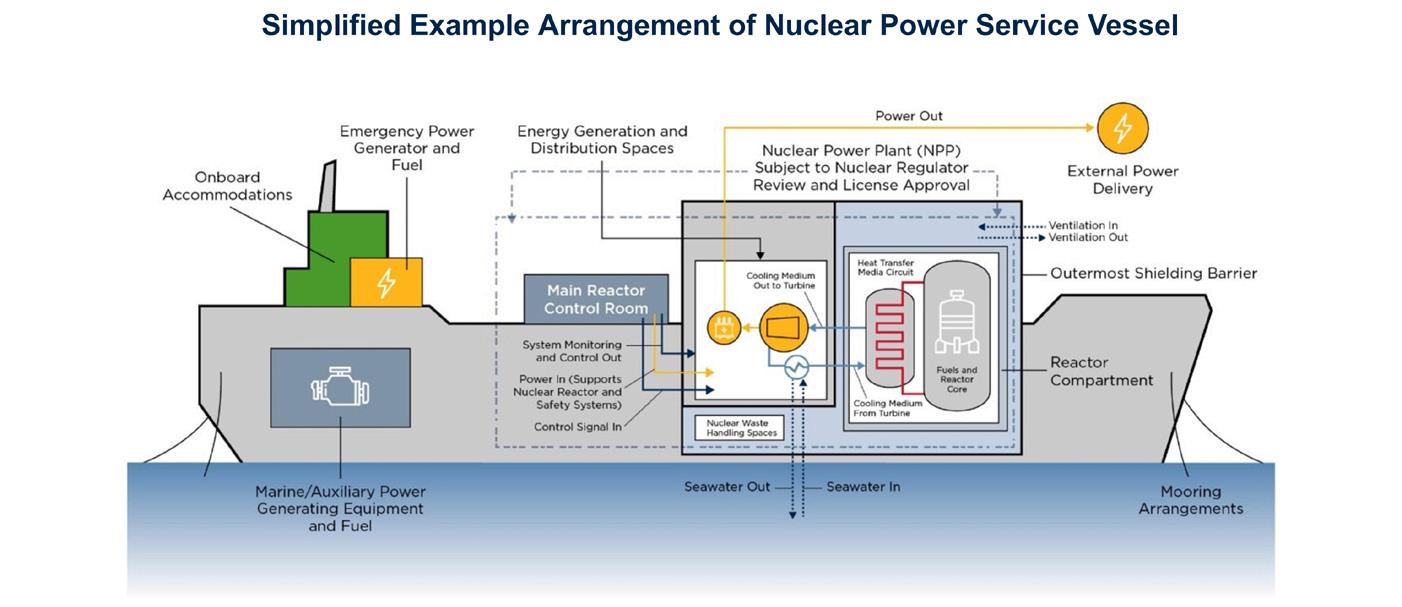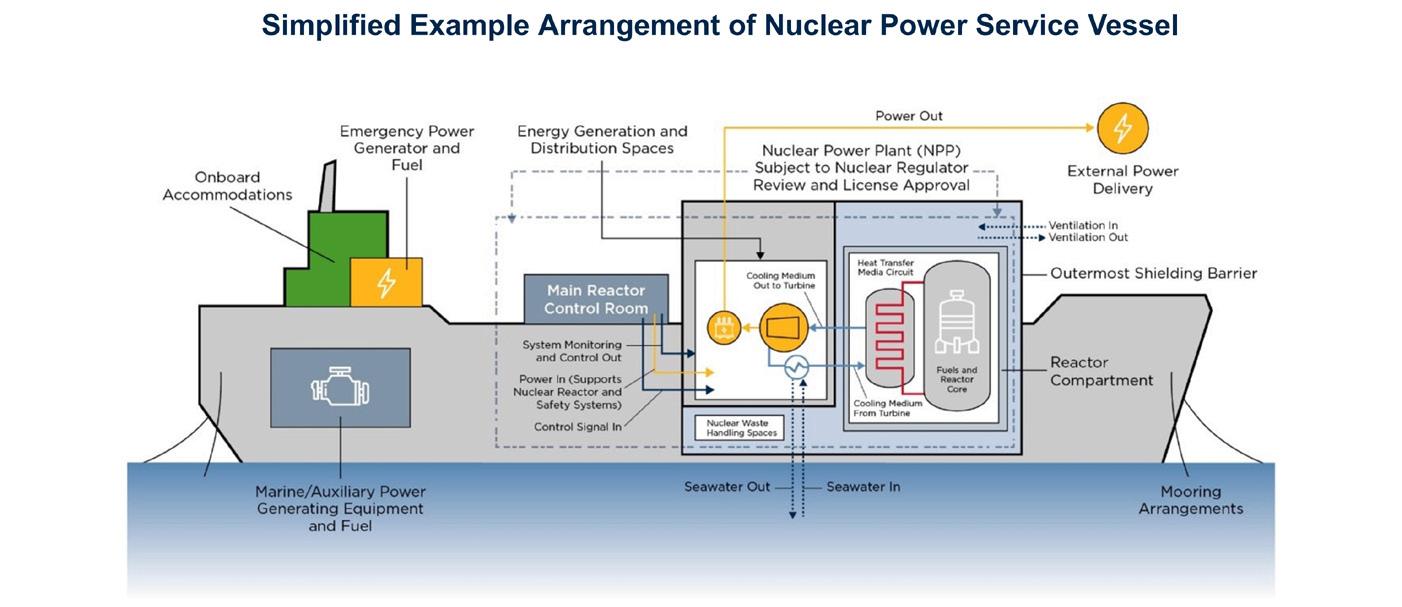
8 minute read
Potential disruptor. Assessing the viability of nuclear power systems in ship, port and fuel product
by Jin Wang, Director of Technology, ABS
Nuclear power has the potential to make a transformational impact on carbon emission reduction across the electricity, industrial and transportation sectors. Its ability to provide clean alternative power generation options in shipping has already attracted attention, and the journey to cleaner maritime energy is gaining momentum. ABS believes that nuclear energy’s potential can be viewed as two stories: nuclear for ships and nuclear for future fuels.
Nuclear power for ships holds out the prospect of using advanced small modular reactors (SMRs) as propulsion, while nuclear for future fuels includes scenarios where SMRs are positioned near shore to produce power for ports and support the production of alternative fuels.
From the perspective of achieving the International Maritime Organization’s 2050 net-zero ambitions, it would be a mistake to ignore nuclear as a part of the fuel mix. However, progress will not happen without regulations that provide a foundational basis for how nuclear-powered systems in the maritime sector could look.
Nuclear energy has the potential to be a disruptor for the maritime sector. Enabling it to be successfully and safely integrated into the shipping industry requires a new kind of collaboration. Developing the technology that could power merchant vessels, provide shore power and generate clean fuels means bringing together players in marine and offshore design with builders of nuclear systems to fill knowledge gaps and exchange ideas. ABS is playing a leading role in helping government and industry work towards the adoption of advanced nuclear technology in commercial maritime, including key research with the U.S. Department of Energy (DOE) and multiple New Technology Qualification and Approval-in-Principal projects with industry.
Both marine and offshore sectors represent high potential demand, sharing as they do an increased focus on clean energy usage. The offshore market exhibits immediate demand due to the power requirement created by ports and other industrial users.
ABS unveiled the industry’s first comprehensive rules for floating nuclear power plants at a forum for nuclear industry leaders held jointly with Idaho National Laboratory. The event saw presentations on the latest reactor technologies from leading companies and the publication of a detailed study from ABS and Herbert Engineering Corporation (HEC) modeling the design, operation and emissions of a floating nuclear power plant. The ABS Requirements for Nuclear Power Systems for Marine and Offshore Applications provide the first classification notation for nuclear power service assets, such as floating nuclear power plants or nuclear-powered floating production, offloading and storage units. Uniquely, the requirements are agnostic to specific reactor technologies and propose a framework for nuclear regulators to collaborate with flag administrations and ABS for complete regulatory oversight and license.
Feasibility study for a floating power barge
ABS believes that nuclear energy’s potential in the maritime domain is much more than a reactor on a ship. Instead, nuclear energy can link demand across the electricity, industrial and transportation sectors to optimize energy generation and support decarbonization of shipping and industry.
With advances in nuclear engineering and the development of many types of advanced nuclear reactors come opportunities to implement the technology for floating nuclear power plant applications. Besides net-zero emission electricity created by a small modular plant, the power barge concept could be extended towards the production of alternative fuels, like pink hydrogen and pink ammonia, for consumption by on- and offshore facilities.
In a joint study, ABS and HEC designed the Navigator platform, with supply to the shore grid in mind, to increase the available power to support maritime decarbonization in port. This study reviewed existing ports fitted with onshore power supply in the US and the typical energy consumption from large ships such as cruise vessels. With these parameters in mind, a platform supplying a maximum of 70MWe to the port’s electric grid was considered sufficient to meet the needs of up to six visiting cruisers at once. The ability to deliver the floating platform to its site location and connect to the local grid from the pier can ease many landside challenges of increasing available power for port operations.
The modular reactor philosophy can successfully be carried over to the floating platform design with significant advantages in terms of safety and cost. Furthermore, the modularity concept allows the power output to be reasonably flexible in adapting to the cold-ironing needs of large ports. Refueling cycles of approximately five years allow the design to be compact and simple, with no need for fuel or high-level radioactive waste to be handled on board.
To conceptualize the possible design, the design team invited a reputable small reactor designer to provide information regarding the use of their reactor design for the floating nuclear power plant. This reactor design has been supported by DOE’s Advanced Reactor Demonstration Program to demonstrate the commercial viability of SMRs.
That said, the main conclusion of this study is that the maturity of advanced nuclear technologies that may be implemented for a floating platform is currently low. Therefore, the level of detail provided in the study is limited to engineering information available from the design of terrestrial applications for engineering postulation and recommendations for future design optimization.
Feasibility study for an LNG carrier
ABS also worked with HEC on the high-level design of a standard liquefied natural gas (LNG) carrier to illustrate how one type of advanced nuclear fission technology could be applied for shipboard power in the future, with an emphasis on what aspects of vessel and reactor design may require further investigation to guide the development of the integrated technology and regulatory framework.
The main conclusions of this study of nuclear-powered commercial vessel designs are that nuclear power would be a supportive means of drastically abating shipping emissions, but significant hurdles remain in public perception and international regulations before this can be achieved.
However, the maturity of advanced nuclear technologies that could be implemented for ship propulsion is low. Therefore, also here, the level of study detail provided was limited to engineering information available from the design of terrestrial applications for engineering postulation and recommendations for future design optimization.
The modular reactor philosophy imposes significant restrictions on ship design, among others, a fixed maximum SMR power output per reactor corresponding to a set lifespan of its core. It is advantageous if the nuclear power plant equipment and fueling life cycles align with the vessel’s life. Challenges with access to suitable shipyards or other support facilities and the physical removal of the reactors could be avoided by addressing them in the design stages.
Although it is possible to operate an SMR at a lower constant power level, this may cause the reactor’s end-of-life to not line up with the ship’s standard dry-docking schedule, thus imposing significant additional operational costs. This means that SMRs would be better suited for just a few sizes per ship type (mostly larger ones). In the design presented in the study, the SMR is considered to have an output capacity of 17.5MWe associated with a core lifespan of five years. This matches well the total power requirement of a 147k m3 LNG carrier, imposing the use of two reactors and a core switch at each special survey.
However, if the same SMR were considered for a QMax LNG Carrier (262k m 3) with a total energy need of approximately 56MW, four SMRs would be needed, operating at around 80% of their maximum power. This would imply a core switch approximately every six years and three months, which would represent the primary driver for service scheduling. This SMR feature may impose limits to ship capacity that can be offered to the market.
The ability of nuclear power plants to tolerate higher accelerations due to ship motions and vibrations can allow for flexibility in the overall design. While there are significant safety benefits to keeping the plants at midships, for specific vessel types like oil tankers and LNG carriers, the midships location would not be feasible or would significantly penalize cargo capacity.
The degree of redundancy required by a nuclear-powered vessel may be higher than a more conventionally powered ship for safety, which causes a decrease in performance. The presented nuclear vessel design has two separate power, propulsion and steering plants, which provide a high level of redundancy compared to no redundancy typically accepted of single screw vessels driven by marine diesel engines. Opportunities for optimization exist on many levels for future design iterations.

Further investigation
Nuclear energy has the potential to be a disruptor for the maritime sector. Our focus is on bringing together major players in marine and offshore design with designers of nuclear systems. ABS can help facilitate filling knowledge gaps that nuclear power companies may have around marine and offshore – and vice versa.
With the feasibility demonstrated for SMRs on board large container ships and gas carriers as well as offshore platforms, it is likely that regulation and reactor licensing will prove the primary driving force in realizing full-scale projects. With renewed interest in building new technologies that are feasible for the marine sector, it will be up to regulators to support the ambition of reducing carbon emissions by enough to meet the 2050 targets.
While the regulatory landscape continues to develop, ABS is encouraging both modular system providers and vessel designers to establish further joint industry projects that can investigate challenges and opportunities.
--
Founded in 1862, ABS is a global leader in providing classification services for marine and offshore assets. Our mission is to serve the public interest as well as the needs of our members and clients by promoting the security of life and property and preserving the natural environment. ABS’ commitment to safety, reliability and efficiency is ever-present. Visit ww2.eagle.org to learn more.








